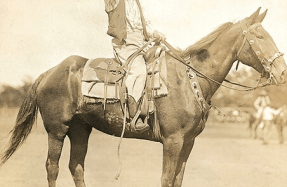‘TEXAS JACK’ TAKES AN ENCORE

The Wild West. It is the fundamental mythology of the United States of America, the iconography and imagery we have chosen to tell the story of who we are as a people and as a country. It is a mythology so enduring that depictions of it stretch from the yellowed pages of dime novels written while the West was still being won to the controllers and keyboards of gamers playing Red Dead Redemption 2. On film, from Edwin S. Porter’s The Great Train Robbery in 1903 through Jeymes Samuel’s The Harder They Fall in 2021, the splendor and danger of the American West has captivated the imagination of generations.
The iconic figures of the American West are just as familiar. There are such stalwart lawmen as Wild Bill Hickok and Wyatt Earp and the outlaws they faced, like Jesse James and Billy the Kid. There are gamblers like Doc Holliday, scouts like Buffalo Bill Cody, and warriors like Crazy Horse (Tasunke Witko) and Geronimo (Goyahkla). Such names—such men—have become more than historical figures, as fiction trumped fact and their legends were superimposed over their lives. Each was a real man, but in the telling and retelling of their tales they have taken on the status of folk heroes, as much Paul Bunyan or Pecos Bill as William Frederick Cody or James Butler Hickok.
Yet when we take a step back from the individuals and the individual stories woven into the tapestry of the American West, a curious theme emerges. Picture a meeting of these great Western men. Standing there are the scout Buffalo Bill, the lawman Wild Bill, the gambler Doc Holliday and the outlaw Jesse James. How are they dressed? Is Wild Bill wearing a marshal’s hat? Does Jesse James have on outlaw boots? Of course not. The wide-brimmed Stetson shading their eyes from the sun is a cowboy hat, and on their feet are tall leather cowboy boots. If the great men of the American West weren’t cowboys, how did the cowboy become the single most iconic figure of the American Western?
The truth is there was a famous cowboy who, their co-star was a real-life cowboy named John Baker Omohundro. Friends called him “Texas Jack.” Born on July 27, 1846 in Fluvanna County, Va., Jack served as a Confederate courier and scout during the Civil War, for a time under vaunted cavalryman Maj. Gen. J.E.B. Stuart, before drifting west to Texas and the life of an open-range cowboy.
You’re reading a preview, subscribe to read more.
Start your free 30 days



